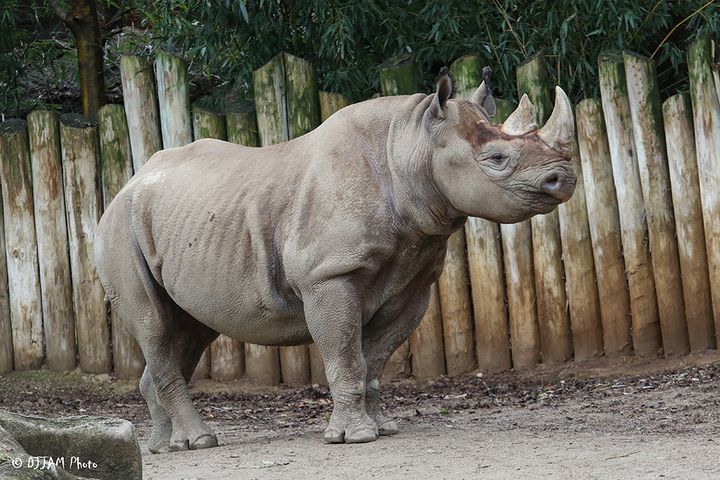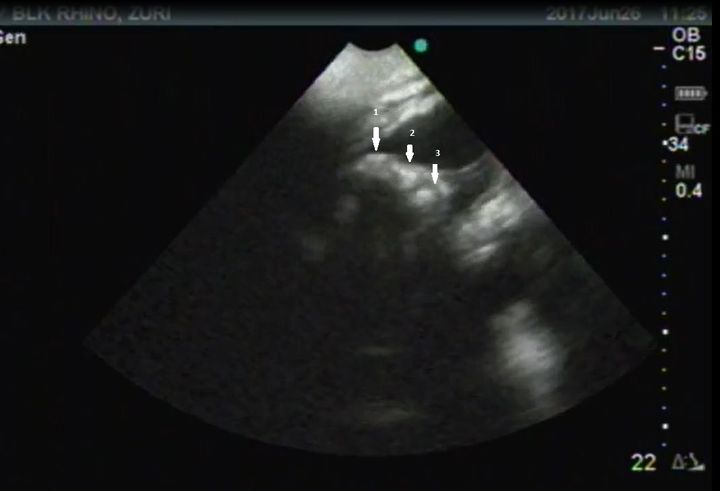
Pregnant black rhino Seyia
Scientists from the Cincinnati Zoo & Botanical Garden’s Center for Conservation and Research of Endangered Wildlife (CREW) have been performing regular ultrasounds on Seyia, the Zoo’s seven-year-old black rhino due to give birth in early July, throughout her pregnancy. The most recent exam revealed that the very active fetus has moved into the correct position for birth, with the feet in front of the head and pointing in the right direction. Seyia's mammary glands have started to fill and other physical and behavioral changes indicate that the Zoo could see a baby soon.
The video above shows the baby’s head and eyeball (nose pointing to the left) and a foot. You can even see the three toes (three bright white dots).

Three toes are visible in this image of the fetus’ foot. The white dots are toenails.
Early in Seyia's pregnancy, CREW conducted monthly ultrasound exams just to verify normal progression. The frequency of exams was increased to weekly about two months ago to monitor the position of the fetus and changes in the thickness of the placenta. The difference in placental thickness observed this week compared to last week was significant and matches up nicely with the other physical changes that her care team has noted.

Black rhinos have a variable gestation length, so the placental thickness data that CREW is gathering will be useful to predict birth dates in the future. Knowing that birth will be within a week of a certain placental measure would be beneficial to animal management.
Zoo vets do not anticipate that Seyia will have any issue with parturition and ultrasounds have revealed a normal pregnancy progression. Fecal progesterone concentrations also indicate a healthy/normal pregnancy. It’s possible that the first time mom will not know what to do with her calf. Plasma from Faru, the sire, has been banked as a precaution in case that happens and the calf has to be hand raised.
Thanks to the Zoo’s emphasis on operant learning, the ultrasound exams on mom and blood draws from dad have been conducted in a non-sedated state with the full cooperation of the adult rhinos. Voluntary participation for medical procedures reinforces that if anything of concern would happen, Seyia could be assessed on the spot.
Black rhinos, native to Eastern and Central Africa, have two large horns made of keratin that they use for defense, intimidation, and feeding. An adult can weigh anywhere between 1,760 and 3,080 pounds, and newborns (calves) weigh between 73 – 121 pounds. They breed year round and have a 15-month (variable) gestation period. The species is Critically Endangered due to poaching and habitat loss. Fewer than 5,000 black rhinos remain in the world, and approximately 115 are managed by the SSP in North American Zoos.
About the Cincinnati Zoo:
The world famous Cincinnati Zoo & Botanical Garden is committed to inspiring visitors to care about wildlife and wild places. It has been rated the #1 attraction locally and one of the top zoos in the nation by Zagat Survey. It has also received rave reviews from Child Magazine, Parents Magazine, USA Today and TripAdvisor. Over 1.5 million people visit the Zoo’s award-winning exhibits, and more than 500 animal and 3000 plant species annually. The Zoo, an accredited member of the Association of Zoos & Aquariums (AZA), is internationally known for its success in the protection and propagation of endangered animals and plants and engages in research and conservation projects worldwide. Known as the #GreenestZooInAmerica, the Zoo is doing its part to conserve natural resources that are critical to saving wildlife and its habitats and is committed to greening its daily operations and reducing its impact on the environment through the use of rain gardens, recycled building materials, solar panels and more. The Cincinnati Zoo is a 501(c)(3) nonprofit organization.
